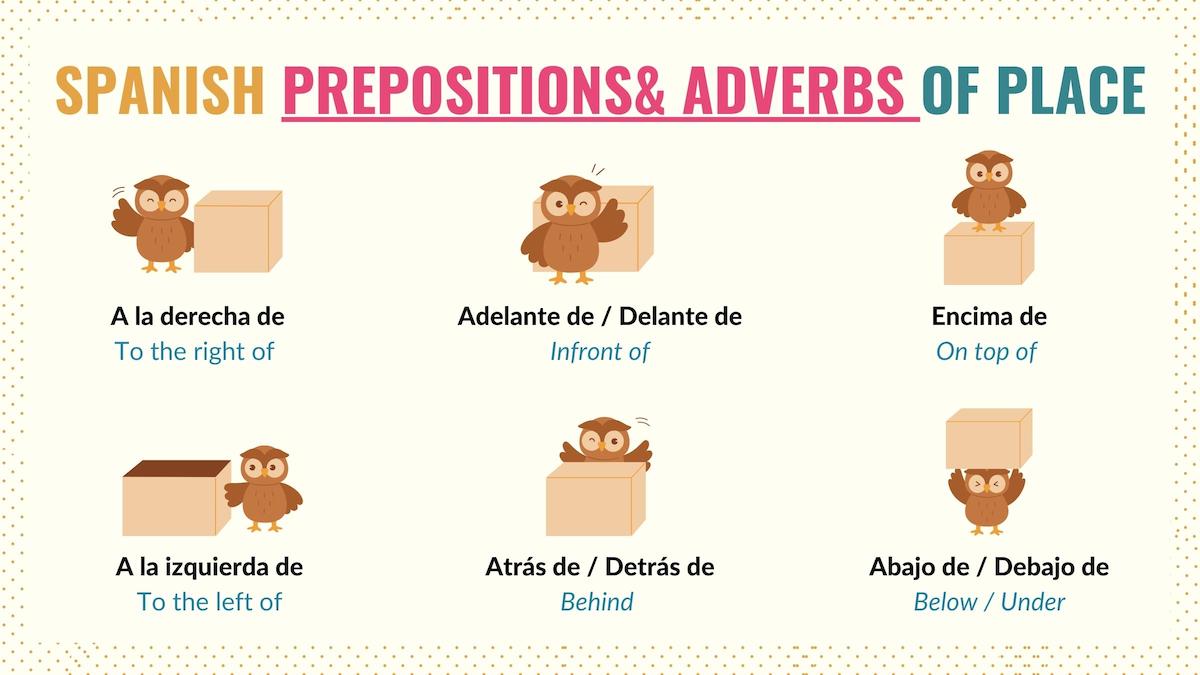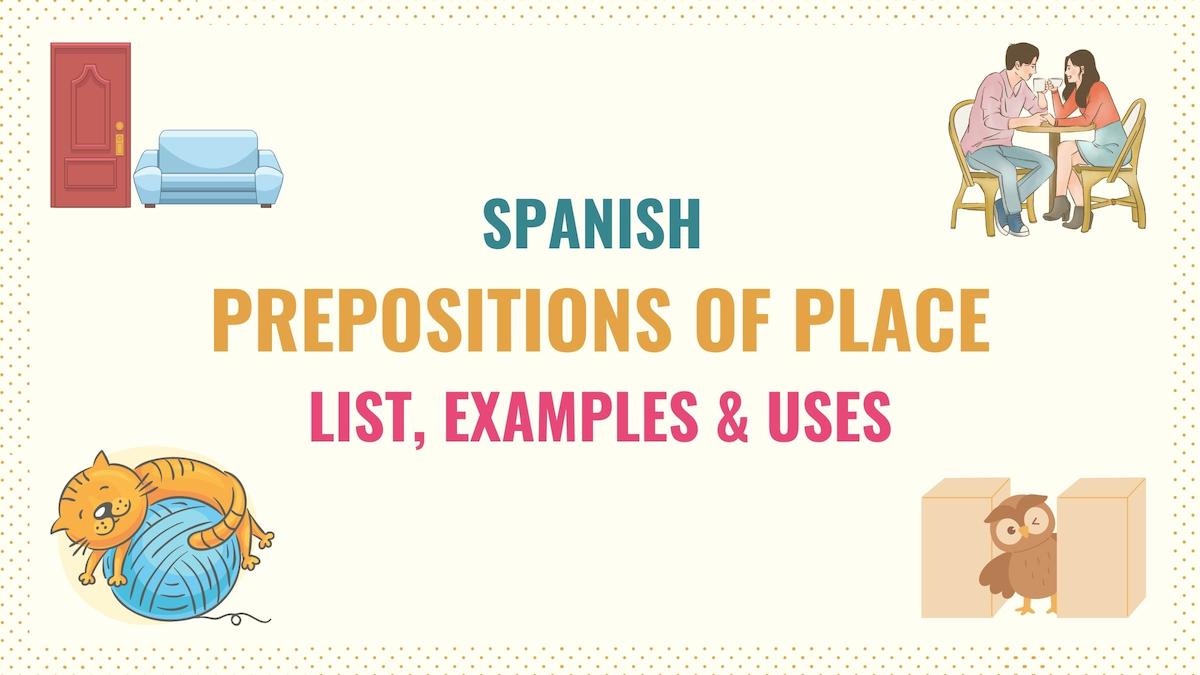Spanish prepositions of place convey precise information about where something or someone is located. Since this type of information is often used in daily interactions, you’ll learn how and when to use these prepositions in this guide.
Here is an overview of what you’ll learn:
- What Are Prepositions of Place in Spanish
- Saying & Asking Where Something Is
- Key Points
- Next Steps & Resources
I’ve included real-life examples to make this topic as easy and understandable as possible.
What Are Prepositions of Place in Spanish
Prepositions of place, also known as prepositions of location in Spanish, indicate where something or someone is located in relation to other people or things. Spanish prepositions of place are:
- Bajo: Under / Below
- En: In / On
- Entre: Between
- Sobre: On / Over / Above / About
Here are some sentences using these prepositions of place:
[Noun] + [verb conjugated] + [preposition] + [noun]
Mis llaves están en la mesa.
My keys are on the table.
La leche está en el refrigerador.
The milk is in the fridge.
Tu zapato está bajo la cama.
The shoe is under the bed.
¿Por qué dejas tus juguetes sobre la tele?
Why do you leave your toys above the TV?
La farmacia está entre el banco y el hospital.
The pharmacy is between the bank and the hospital.
Take Note: The verb estar is often used to ask and express location. However, you can also use other verbs as needed.
Sobre vs En
In Spanish, the preposition ‘en’ is used to talk about things inside or on the surface of something. On the other hand, ‘sobre’ is more commonly used to refer to subjects or topics. As a preposition of place, ‘sobre’ also indicates that a person or thing is on top of something else.
Here are some examples:
El celular está en tu bolsa.
Your phone is in your bag.
El control está en la mesa.
The remote is on the table.
Dejé las llaves sobre tu bolsa.
I left your keys on top of your bag.
Hablamos sobre ustedes.
We talked about you.
Sobre can also indicate that something is over or above a person or thing. This is often used when there’s no contact between such things. For example:
El pájaro voló sobre nuestras cabezas.
The bird flew over our heads.
Take Note: ‘Encima de’ is more common than ‘sobre’ when talking about position.
Prepositions and adverbs of place in Spanish
Spanish prepositions are often combined with adverbs of place to express location more precisely. These are called Spanish prepositional phrases of place:
- A la derecha de: To the right of
- A la izquierda de: To the left of
- Abajo de / Debajo de: Below / Under
- Adentro de / Dentro de: Inside of
- Adelante de / Delante de: In front of
- Al lado de: Next to
- Alrededor de: Around
- Atrás de / Detrás de: Behind
- Cerca de: Close to / Nearby
- En frente de: Across from / In front of
- En medio de: In between / In the middle of
- Encima de: On top of
- Junto a: Next to
- Lejos de: Far from
Here are some sentences using these phrases:
[Noun] + [verb conjugated] + [prepositional phrase] + [noun]
El bebé está abajo de la mesa.
The baby is under the table.
El gato está adentro de la caja.
The cat is inside the box.
Tu papá está delante de mí.
Your dad is in front of me.
Los museos están al lado del parque.
The museums are next to the park.
El supermercado está enfrente de la pastelería.
The supermarket is in front of the bakery.
Voy a poner tu celular encima de tus libros.
I’m going to put your phone on top of your books.
Take Note: Del and al are Spanish contractions you must use when the prepositions ‘de’ or ‘a’ are followed by the singular masculine definite article ‘el’.

How to Say & Ask Where Something Is in Spanish?
As established before, estar is the most common verb used to ask and express location. This verb will be conjugated in plural or singular form depending on whether you’re referring to the location of single or multiple things.
Está + [singular determiner] + [noun]
¿Dónde está la parada de autobús?
Where is the bus stop?
Tu cartera está en tu bolsa.
Your wallet is in your bag.
Están + [plural determiner] + [noun]
¿Dónde están mis lentes?
Where are my glasses?
Los boletos están junto a la licuadora.
The tickets are next to the blender.
As variations, you can also use the expressions:
- ¿Dónde se encuentra…? – Where can I find…?
- ¿Dónde queda…? – Where is…located?
Key Points
Prepositions of place in Spanish are crucial for daily life interactions, such as giving directions or expressing where something is located. Here are some key points you should know:
- In Spanish, prepositions of place convey where a person or thing is in relation to something or someone else.
- En is one of the most common prepositions of location in Spanish. It’s the equivalent of the English prepositions ‘on’ and ‘in’.
- Prepositions + adverbs of place (prepositional phrases) convey the location more precisely.
- Most Spanish prepositional phrases of location use the prepositions ‘de’ and ‘a’.
- De and a are contracted to ‘del’ and ‘al’ when followed by ‘el’ (singular masculine definite article).
Prepositions of Location in Spanish Additional Resources
Now that you’ve learned how to use prepositions of place in Spanish, here are some resources you may want to check out next.
As you saw in this guide, prepositions of location explain the position of a noun in relation to others. Spanish prepositions are important words that express cause, temporal, and spatial relationships within a sentence. So, make sure you understand how these words work.
Also, you may want to learn some common nouns in Spanish since you’ll use these terms as reference points. Finally, get familiar with estar conjugations because this verb is essential to expressing location.
Download the Spanish Prepositions of Place PDF
Using prepositions of place effectively in conversations is one of the key aspects of Spanish that will differentiate the Spanish beginner from more advanced speakers. Applying them and prepositional phrases correctly and precisely takes time and practice. Download the PDF for this guide to get the key points and graphics above to study or refresh your knowledge when you need it.

